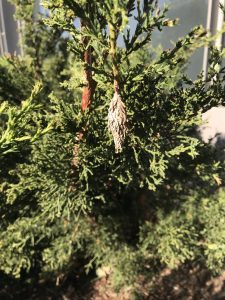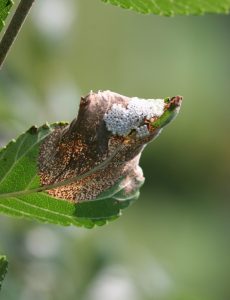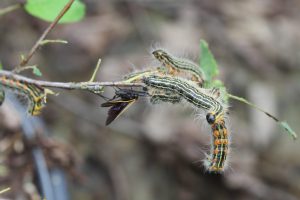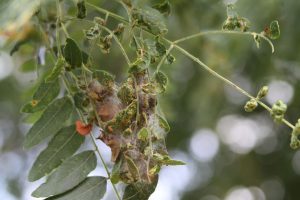Several caterpillar pests feed on trees and shrubs in July. Although most trees can tolerate some defoliation, the injury can be unsightly for much of the summer. Damage to plants can be reduced by timely applications of insecticides. Proper choice of insecticides can reduce impacts on pollinators and natural enemies of spider mites that do well during the heat of the summer. Foliar applications of insecticides can be a challenge for homeowners. Although some products can be applied to the soil, label precautions must be followed to ensure that the insecticide reaches the canopy and does not burn leaves.
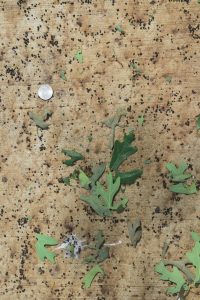
Look up into the tree canopy for caterpillars when you see black pellets of caterpillar feces collecting on the pavement below a tree. These pellets were produced by spongy (previously gypsy) moths feeding on oaks during June (Photo E. Barnes). In the northern part of Indiana these caterpillars can continue to feed until early July.
Early detection of caterpillar activity is critical to successful control of these pests because smaller caterpillars are killed more easily by insecticides. While some caterpillars are easy to spot on small trees and shrubs, most are invisible to the naked eye from the ground. It is much easier to spot fecal pellets that caterpillars drop on to patios, lawn furniture than up in the tree-tops. You can then use a pair of binoculars to inspect the leaf canopy above for chewed leaves.
To avoid problems with spider mites later in the season, it is best to use products that do not kill the small lady beetles, lacewings and predatory mites that kill spider mite predators. A complete list of biorational pesticides is available in our Extension bulletins about caterpillar pesticides. Common foliar products that fall into this category include those with the active ingredient spinosad (Fertilome Borer and Bagworm Killer, Captain Jack’s Deadbug etc), the bacterium Bacillus thuringiensis (Thuricide) as well as several insect growth regulators and other novel products like chlorantraniliprole.
When the weather forecasts pop-up thunderstorms, it can be difficult to control caterpillars with these slower acting products. In these cases, more conventional products including the pyrethroid insecticides (bifenthrin, or cyfluthrin) can be effective if allowed to dry before a rain. A list of these conventional products are also available in our caterpillar bulletin.
Controlling caterpillars on tall trees can be out of reach for most conventional home sprayers. Similarly, even professionals with more powerful spray equipment can have a difficult time applying a product on a tall tree without considerable drift to other plants and properties.
Professionals have a number of options for controlling caterpillars on large trees. Soil applications of acephate (Lepitect) can provide protection in a couple of days. Although this product does kill caterpillars and some mites, be aware of the list of plants on the label (like some poplars and crabapples) whose leaves may be burned by a soil application of this product. The soil must be moist for the roots to absorb the product and move it up into the leaves.
Tree injections with emamectin benzoate avoids the problem associated with acephate soil injections. The product moves rapidly into the leaves and can start killing caterpillars in a few hours. Although this product is effective, it important to note that it only works during the season in which the tree has been injected. While a few years of back to back injections are unlikely to harm trees, the impact repeating this practice for decades to prevent caterpillar injury is not known. Fortunately, most caterpillar populations come and go after just a few years, so annual treatment is not likely to be necessary.
Here are some common caterpillars you may encounter:
- Although bagworms have been feeding since early June, if left unchecked they will continue to grow throughout the month of July. Larger caterpillars can completely strip junipers, spruce and arborvitae of leaves and kill the plant. They are also common on deciduous trees where they cause much less damage.
- Egg masses laid on leaves in late June will hatch in small caterpillars in July.
- In late summer parasitic wasps will find yellow-necked caterpillars and lay eggs inside their bodies. Eggs consume the insides of caterpillars eventually killing them and reducing their number. This youtube video of a parasitized tomato hornworm shows all the gory details.
- Small webs left by mimosa webworm on branches of honeylocust trees harbor green caterpillars that emerge in late July. This second generation is often larger than the first and causes much unsightly damage.
Resources.
